Japanese knotweed and the law
This page covers Japanese knotweed Law, what you need to know & who is responsible for Japanese knotweed and what to do if you find knotweed.


Want to know if it’s knotweed? Our free online ID tool sends your plant images direct to our team of Japanese knotweed experts who will get back to you same working day if possible. Fill in the form below.
Trust Pilot review 2024: “Peace of Mind – I live next door to a garden with untreated knotweed. The identification service is quick and efficient and I know it will be quickly resolved if it does invade my garden.”
Japanese knotweed is a highly invasive and resilient weed that can cause damage to your property and lower the value of your home. It can be difficult to identify but being able to spot the signs of a Japanese knotweed infestation early is advisable.
If you’re wondering “how can I tell if it’s Japanese knotweed?” this page provides all the information you need, read on to find out what knotweed really looks like.
Contents
Since Japanese knotweed (Reynoutria japonica) is such an invasive and resilient weed, it is important to be able to identify it early. Japanese knotweed can be treated with herbicide, and this will stop the aerial growth that you see above the ground, but the roots – known as rhizomes – are capable of supporting life for up to 20 years.
Japanese knotweed can re-emerge and re-grow of its own accord any time, but especially if the contaminated ground is disturbed by gardening or construction activities. If the Knotweed infestation is left unchecked for several years, it can spread and cause a range of issues including:
In the UK, we only have the ‘female version’ of the plant. The roots of Japanese knotweed are known as rhizomes, or ‘creeping rootstalk’. These are a horizontal underground plant stems that produce the shoot and root systems of new plants. These networks can stretch for 3 metres or more from the visible ‘areal growth’ of the plant. Even small fragments of rhizome can give rise to a new plant. This is why it is so important to learn how to identify Japanese knotweed.
Like many species of weed, knotweed is very active during the spring months. This is a good time to watch for signs of knotweed growth in your garden, business premises or land.
New growth appears as rapidly growing soft red/purple shoots reminiscent of asparagus spears, growing into stronger, upward shoots with hollow stems that look like bamboo and can grow up to 10cm per day. This new growth forms dense thickets, known as stands. The emerging leaves grow on alternate sides of the stem producing a zig-zag pattern in the stem, with a leaf shooting from each ‘zig’ and each ‘zag’.
Still unsure? Use our free identification service. Use the form at the top of this page to send us a few pictures of the plant that concerns you, or email your pictures to ident@knotweed.co.uk.


During the summer months, Japanese knotweed becomes fully formed with large shovel shaped green leaves, forming a dense canopy. Leaves can grow up to 200mm long. Japanese knotweed canes grow to around 3 to 3.5m tall. It will often form as a semi-dense stand of upright stems. As summer continues, knotweed begins to form clusters of creamy-white elongated flowers. The canes grow to around 3 to 3.5m tall in summer, often forming a semi-dense stand of upright stems, with lush green foliage.
During the summer months, the volume of other flowering plants and weeds can make it tricky to identify knotweed. Our experts are fully trained to identify knotweed (and other invasive species).
Still unsure? Use our free identification service. Use the form at the top of this page to send us a few pictures of the plant that concerns you, or email your pictures to ident@knotweed.co.uk.
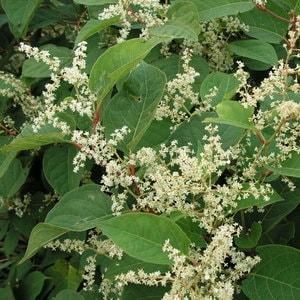
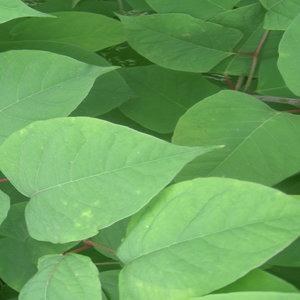
In Autumn the dense covering of leaves will remain, however, they start to turn yellow and orange and appear more brittle. The leaves wilt as we move into September and October. At this stage the knotweed plants are still about 2-3 metres tall, and the hollow stems start to turn brown. Once the leaves start to fall the canes become more easily identifiable.
Still unsure? Use our free identification service. Use the form at the top of this page to send us a few pictures of the plant that concerns you, or email your pictures to ident@knotweed.co.uk.
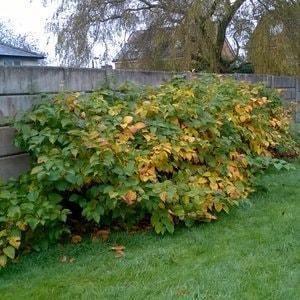

Identifying Japanese knotweed in Winter can be a little tricky as some of the most identifiable signs are its leaves and flowers, and in Winter knotweed will have lost all of its leaves, but the long clustered shoots will remain. These canes will die off and turn brown and brittle however will remain erect through the winter if left undisturbed.
This isn’t the end of the weed, however – its crown and rhizome remain dormant throughout the winter, waiting for spring to return so that they can start the cycle again. Identification of its rhizomes is the perfect opportunity to directly tackle the problem with excavation and removal. Digging out and if required replacing the contaminated ground at a time when the weed is dormant, and when the garden or green areas are generally used less is a great option.
Still unsure? Use our free identification service. Use the form at the top of this page to send us a few pictures of the plant that concerns you, or email your pictures to ident@knotweed.co.uk.

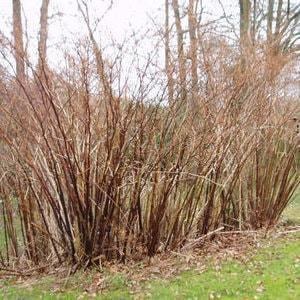
Knowing what Japanese knotweed looks like can really help you to identify a problem. There are quite a few weeds out there that can easily be mistaken for this foreign invasive species. One of the most identifying features of the Knotweed are the leaves.
Japanese knotweed leaves are shovel-shaped (not to be confused with heart-shaped) with a point at the tip and staggered on the stem (one stem per node), creating a zig-zag stem growth pattern which is quite characteristic. They’re a luscious green colour and grow up to 200mm long.
Still unsure? Use our free identification service. Use the form at the top of this page to send us a few pictures of the plant that concerns you, or email your pictures to ident@knotweed.co.uk


Another defining feature of Japanese knotweed appears in the summer months towards the end of August and early September when it begins to flower. Knotweed will produce elongated clusters of creamy white flowers that grow to around 0.5cm wide and 10cm long.
The leaves will still be visible along with the flowers and together, can often create a dense foliage. The distinct leaves combined with the flowers can make it easy to identify if the weed is Japanese knotweed.
Still unsure? Use our free identification service. Use the form at the top of this page to send us a few pictures of the plant that concerns you, or email your pictures to ident@knotweed.co.uk

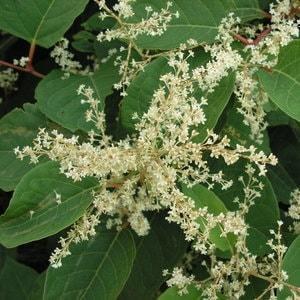
While doing work on your garden, land or commercial site, you may come across the roots of Japanese knotweed. These roots are known as rhizomes and work like underground stems.
If the roots are fresh, they will snap easily like a carrot. The outside is dark brown, and the inside is orange/yellow in colour.
The root system can grow to depths of 2 metres and extend up to 7 metres horizontally from the visible part of the plant. These roots are what allows knotweed to spread and are part of the reason that it is so resilient. It only takes a small amount of healthy root to give rise to an entirely new plant – and cause the infestation to re-emerge.
Still unsure? Use our free identification service. Use the form at the top of this page to send us a few pictures of the plant that concerns you, or email your pictures to ident@knotweed.co.uk
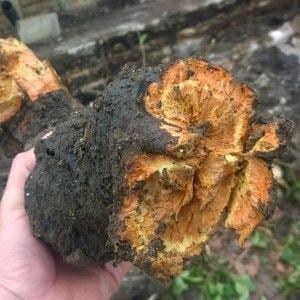

Japanese knotweed stems grow to 2-3 metres tall. In the summer months they’re similar to bamboo in shape and size but the stems are distinctive with purple speckles and vibrant green leaves shooting from each node on the stem (as shown by the image below).
At they mature the stems are hollow and when cut have a pale green fibrous flesh inside. During winter the stems dry out, turning brown and brittle.
Still unsure? Use our free identification service. Use the form at the top of this page to send us a few pictures of the plant that concerns you, or email your pictures to ident@knotweed.co.uk



